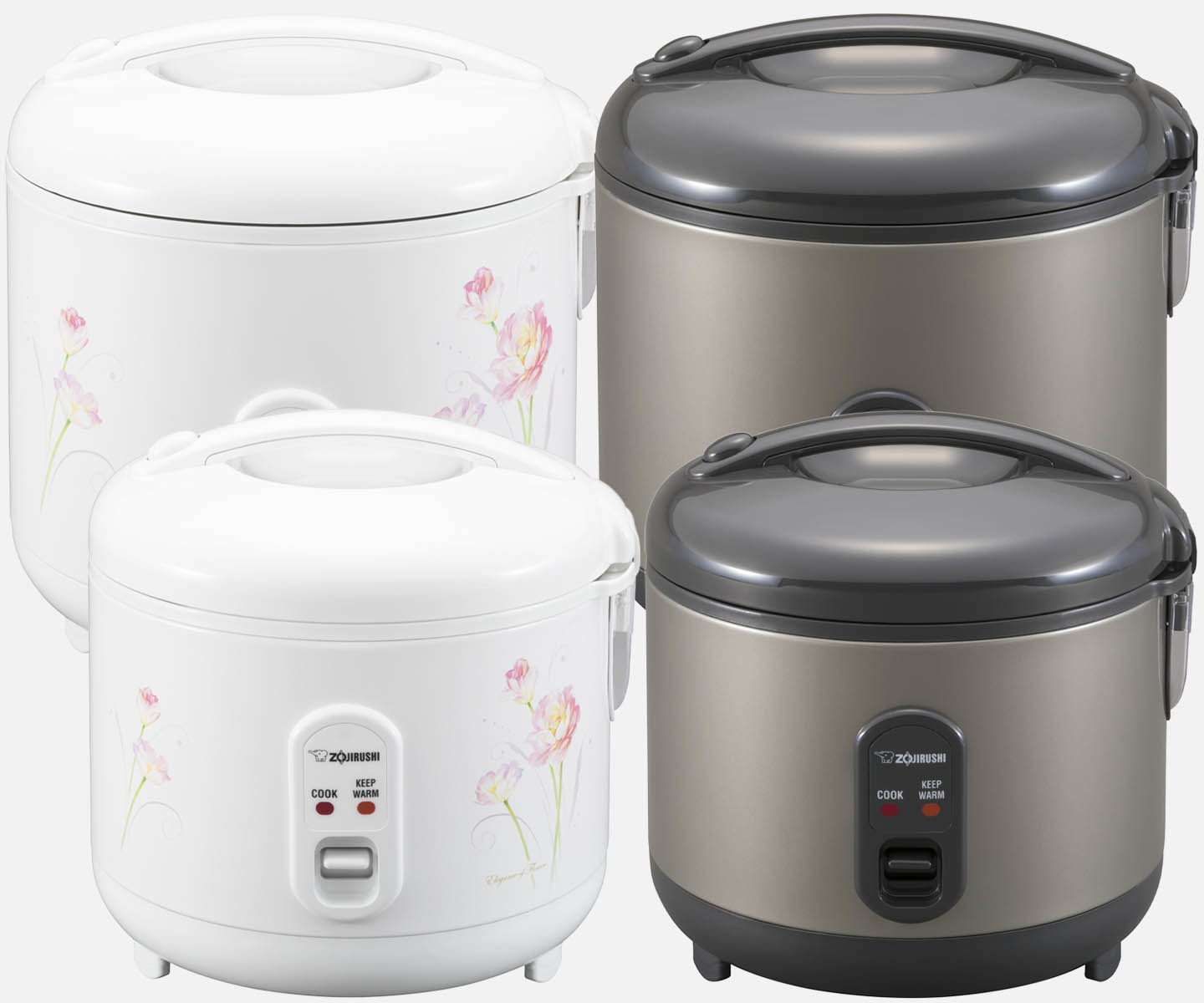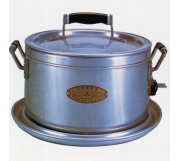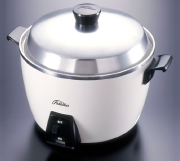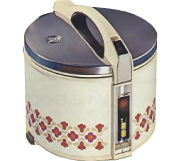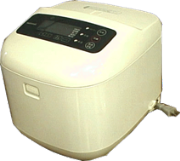Living in Asia, I’ve seen a few rice cookers that have the thickness of 1 side very significantly different from the opposite side, despite the fact that both the inner pot & the outer case are round. Do you also have the same experience? If yes, why is that?
Can you give a link to some examples so we can see what you mean? Most likely, the manufacturer starts with a round pot and round outer case, and then shapes the outer case in one direction or another to house the various electronic bits and for design aesthetics/cost.
That’s my bet.
The front is usually longer and I don’t recall seeing any where one side is asymmetrical.
I’ve owned only very simplistic rice cookers, but they’ve all been symmetrical except for the small housing tacked on the front for the controls.
We get the ones we have used over the years directly from Asian markets. They have all been round.
I’ve got a high end Cuckoo rice cooker with a lid that’s slightly tilted. That’s more an aesthetic thing.
I would guess the electronics panel as well. Many models have all that stuff on the top or aren’t complicated enough to protrude too much but some have them protrude a fair amount from the ‘front’ and include all the computer-y goodness to allow for different cook options, timers, etc.
My old Zojirushi is a perfectly level and even cylinder. The only thing that keeps it from being a perfectly symmetrical cylinder are the bumps for the top hinge, top latch, and the front panel.
Perhaps it’s a recent-ish “fashion” thing.
My current rice cooker is like a rounded rectangle, with the controls in the front. Some are more oval and others are more rectangular, but I’ve never seen any asymmetical right and left.
We just bought our rice cooker in March when we came back to Japan and I looked online and in stores at many, many cookers. There may have been some round ones, but the rounded rectangle and ovals are popular now.
The classical shape in Taiwan are completely round.
Here you are Imgur: The magic of the Internet
The right side is thicker than the left. But as someone mentioned, that side has the interface, too, so I guess it’s the practical purpose of insulating the chipset board or something.
There is a pretty interesting video showing how they’re manufactured: https://www.youtube.com/watch?v=xLCwr8qG1p4
Shows what goes on behind all the plastic (the fancy electronics and such).
That’s interesting. What country is that? The plug looks like it’s somewhere like Singapore, Hong Kong, or Malaysia.
The rice cookers being sold in Japan look like this.
The ones in Taiwan, which are used for steaming as well, look like this.
Those of us who are old-school still prefer this type. I assume they’re still available in Japan, since they’re still being made.
That brand is Japanese and available there (and elsewhere - Zojirushi being a fairly well known brand used worldwide) but that general style/shape of rice cooker is generally available most places in East Asia across a number of manufacturers.
The fancier cookers are good for other things as well - they don’t result in burnt/crispy bits (unless you deliberately want that and there’s a setting for it), different types of rice or grains, timed cooking, temperature controls, etc. Note Zojirushi also has the more modern looking models with all the bells and whistles as well. Rice cookers, like most kitchen appliances, are available in several price and tech ranges even by the same manufacturer
I’m going to guess you don’t use yours as much as I do mine, which may average 10 to 12 times a week.
Old school is nice and fine, but I can’t live without a timer, at the very least.
My wife or I make bento lunches for my kids daily, with rice, and they have rice for breakfast several mornings a week.
I would go crazy if I had to wake up an hour earlier to start the rice cooker.
The really nice thing about the cooker is that there are two timers, so I leave one set for mornings and the other for dinner time. The latter is especially convenient when are going to be out before dinner. The other food can be cooked quickly, but rice takes longer. We can have dinner in 30 minutes after getting back rather than an hour.
I don’t use some of the functions, but my model
lets you select the various types of rice and cooking speeds. It lets you choose what temperature to keep the rice warm after cooking, and to reheat the rice if desired.
In the inner menue, there is 無洗米, musenmai, no-wash rice a godsend in Hokkaido winters, as well as just being convenient at anytime.
There is a setting for cooking rice faster when you are in a hurry or slower when you have time. Personally, I don’t really tell the difference but Japanese claim they can.
My wife and kids like おかゆ (お粥 oyayu, [rice porriage]) (Rice Porridge Recipe (Okayu) お粥 • Just One Cookbook) second down on the right side and there is also 玄米 genmai.
The other one I often use is 炊き込み takikomi (gohan) and the results are really good. I’ve never tried making takihomi-gohan in a traditional rice cooker, but I presume this setting has been optimized.
When we moved to Taiwan 10 years ago, we got a traditional Taiwanese steamer / rice cooker, but also took our Japanese one. Guess which one got used?
After coming back this year, this was the model we selected.
We skipped the high end models such as this one
on Black Friday sale for 109,800 yen ($740).
Japanese will eat rice up to three times a day, 365 days a year. They get serious about their cookers.
No doubt.
I suspect I inherited my denkigama conservatism from my Japanese mother. It’s what she used, and it’s what I use.
Of course, I’m not Japanese (only half), and I’ve got a completely white-bread family, so we only use our simple rice cooker about 2-3 times a week.
That’s interesting. About when did she emigrate? There was a change in vocabulary from denkigama to suihanki in the late 80s.
There’s an interesting history here. The following is from this site in Japanese.
電気釜 denkigama, “electric rice cooker” was first invented in 1924.
The first ones with an automatic off switch 自動式電気釜 was invented in 1955.
In 1972, the first rice cook with a feature to keep the rice warm 保温ジャー temperature “jar” was introduced.
Then in the late 80s saw the introduction of “modern” type of rice cookers with IH (inductive heater) technology. The internal pan is metal.
At this point the Japanese terminology changed and the common word used now is 炊飯器 suihanki rice cooker.
釜 kama /gama is a pot, and rice traditionally was cooked in 土鍋 donabe earthenware pots. All the electric cooker pots were metal until 2016 when IH 土鍋 炊飯器 donabe suihanki were introduced, but they are very expensive so most cookers still use metal pots.
The high end model in my previous post uses this technology.
Japanese housewives have quickly adopted the ongoing changes in rice cooker technology because of the real convenience on a daily basis.
- She was born in 1930.
So you mom is just a little older than mine.
Yeah, it was well before suihanki became the established term.
I’ve asked a number of Japanese friends and coworkers in their 40s and 50s to see if anyone ever used “denkigama” but while they were familiar with the term, they said they’ve always used “suihanki”.
Some said their mothers used the older word while others said their grandmothers used that.
So, bringing back around to the original question: there are still very symmetrical round rice cookers, but they’re living fossils, like the frozen fossil of the Japanese word my mother used.
I suspect the rectangular shape became popular at least in part for fashion reasons. The first non-cylindrical rice steamers I saw were the Zojirushi “Micom” branded ones when they were first introduced. The deluxe feature set of a microcomputer-controlled cooker seemed to go with the new shape and color. So there evolved the marker expectation that a modern cooker with modern conveniences would have a modern shape.
Asymmetry was a part of that design choice.
That’s my theory, anyway.


